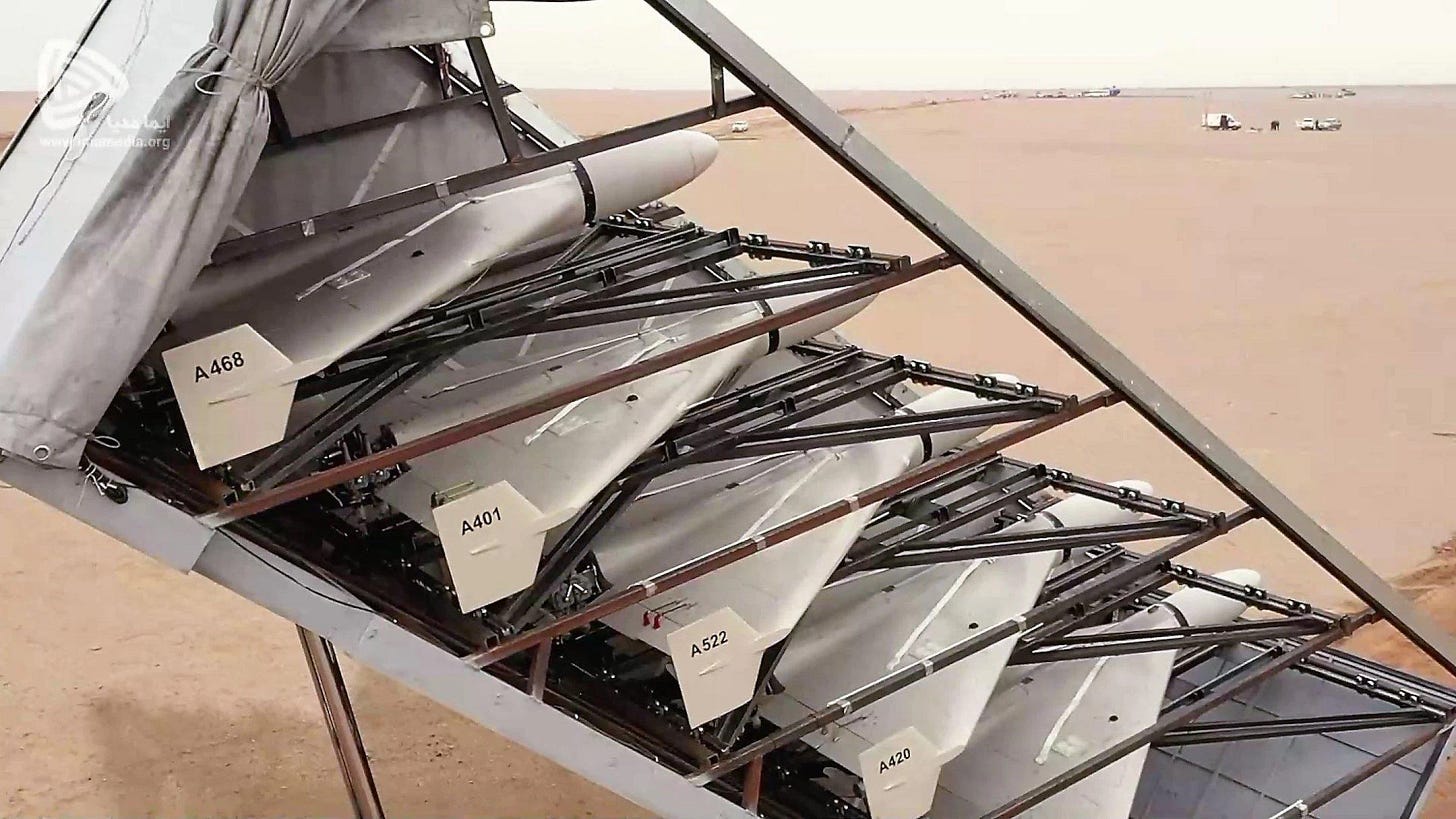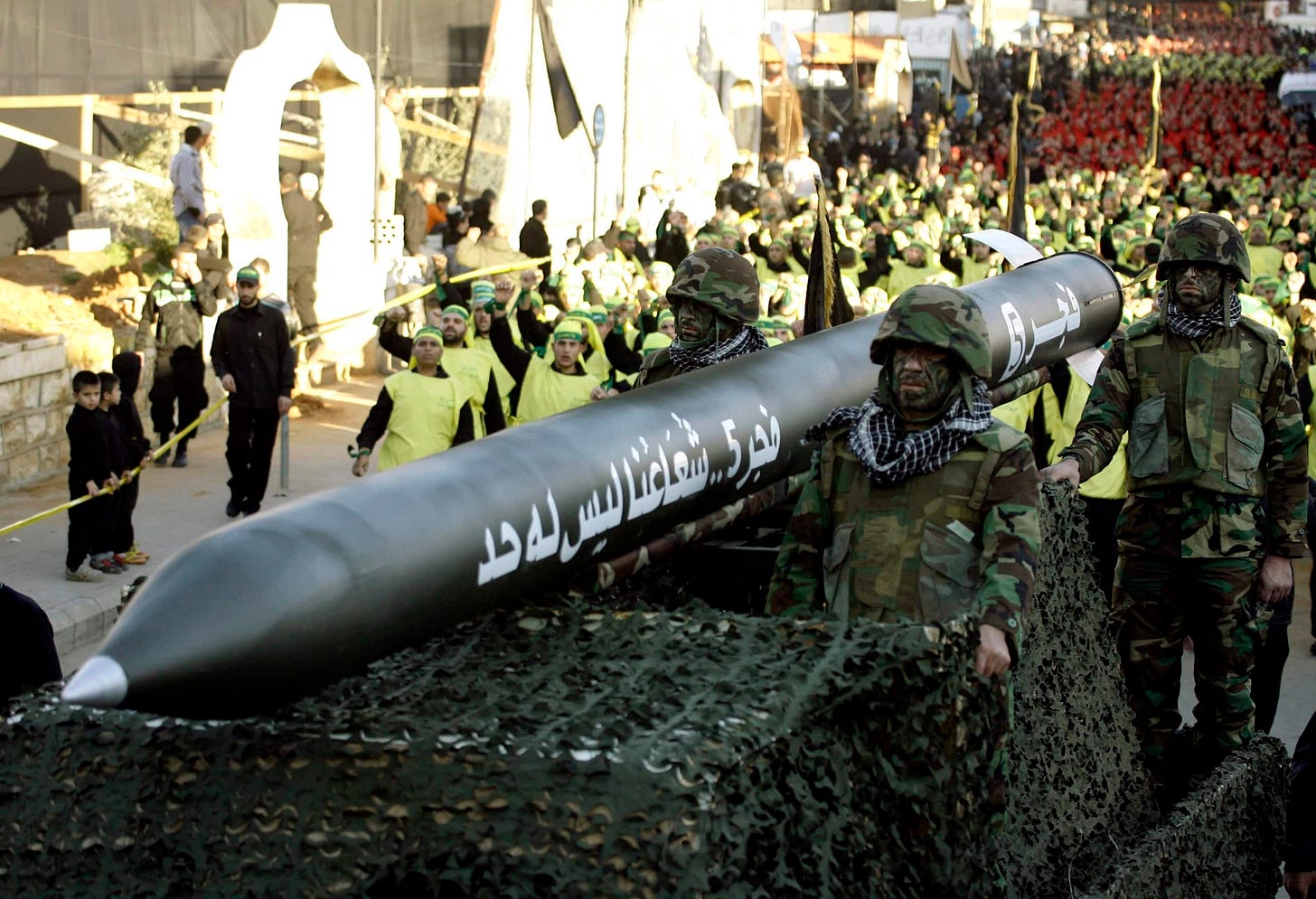Beware Iran’s Military-Industrial Complex: How Tehran is Changing the Nature of Asymmetric Warfare
Iran has spent decades developing the kind of technologies it needs to wage asymmetric war, and we are just beginning to see the consequences...
Iranian Shahed-136 kamikaze drones stacked and ready to launch. Each unit costs as little as $20,000. Source
Asymmetric warfare requires the utmost ingenuity on the part of the lesser power, particularly regarding the development and use of technology. The January 28 attack on Tower 22 in northeast Jordan that killed three US service members using an Iranian-made drone made headlines around the world and demonstrated the vulnerability of forces stationed throughout the region. Tehran developed these and other technologies due to a decades-long understanding that it cannot confront its regional or global adversaries by conventional means. For this reason, Iran has excelled at adapting foreign technologies and developing new ones to create an arsenal of highly effective, low-cost weapons for export to its proxies and allies. Now, we are seeing the permanent impact of this on asymmetric warfare on a broad scale.
How Iranian drones work to level the playing field
Shahed-136 technical specifications. Source
Regular reports that Iran’s production and export of unmanned aerial vehicles (UAVs) continue to be scaled up has been a growing cause for concern in recent years. Tehran’s adoption of UAVs was due to its need to wage war asymmetrically. It first adopted the technology in the 1980s to help gain air superiority against Saddam Hussein’s better-equipped forces in the Iran-Iraq war. Today, Tehran produces a wide array of UAVs, such as the Mohajer-10, an advanced Kamikaze model capable of striking Tel Aviv, and Kaman-22, the ‘world’s longest range drone’ capable of remaining airborne for 24 hours. Although the Iranian military extensively employs powerful units such as these and sells them for conventional military use in countries such as Sudan, Iran’s lower-cost models may have an even greater impact on battlefields worldwide.
The Shahed 136 one-way attack drone is said to have a range of around 2,500 kilometres with a warhead payload of between five and 30 kilos. These have been extensively on the battlefield in Ukraine, with Russia launching some 2,000 of these since the start of the war and 500 last September alone. At just $20,000 – 40,000 per unit, the Shahed 136 is a much more cost-effective alternative to precision-guided missiles, costing as much as $1 million each. Although Ukraine’s air defence systems intercepted many of these drones, their comparatively low cost brings benefits to Moscow, regardless of the outcome: “The Russians are trying to impose costs on Ukraine and have them use half a million-dollar missiles to shoot down 20,000-dollar drones to exhaust expensive missile stocks,” said Retired Australian Army Major General Mick Ryan.
In addition to their extensive use on the Ukrainian battlefield, the Washington Institute speculates that Iran may be outsourcing production of the Shahed 131 and 136 to Venezuela, potentially making inroads into other markets in the Americas. The low cost of the Shahed 136 has made these an affordable weapon not only for state actors, but also non-state actors with considerably less financial means. Most recently, the Houthis in Yemen and Kataib Hezbollah in Iraq have made headlines for using these units or local derivatives thereof. These weapons have allowed relatively weak non-state actors the ability to punch well above their weight, inflicting severe damage in the region while shutting down much of the traffic on one of the world’s key sea lanes. In this way, Iranian drones have brought about a new phase in global asymmetrical warfare.
Iran’s Kaman-22 (below) is believed to have been adapted directly from the US-made MQ-9 Reaper (above). It can reportedly remain airborne for up to 24 hours. Source
Export destinations for Iranian-made drones. Source
Iranian ballistic missiles could set a big part of the world ablaze
Iran’s Khaibar Shekan long-range missile was recently used to strike targets in Syria, Iraq, and Pakistan. Source
Iran has the most extensive ballistic missile program in the Middle East, producing and exporting a wide range of units ranging from solid and liquid fuelled and short- to long-range models. On January 17, the Iranian Revolutionary Guard Corps carried out attacks using precision-guided Khaibar-Shekan long-range missiles, hitting enemy targets in Pakistan, Iraq, and Syria while demonstrating Tehran’s ability to strike targets in Israel.
Tehran’s proxy in Lebanon, Hezbollah, is believed to possess some 150,000 medium- and long-range missiles aimed at Israel, a substantial portion of which are of Iranian origin or design. With a capacity to launch as many as 4,000 of these per day, Hezbollah is capable of overwhelming Israel’s air defences, making it capable of inflicting substantial damage to Israeli cities and critical infrastructure. Iran has also transferred ballistic missiles to the Assad regime in Syria as well as non-state actors such as Kataib Hezbollah in Iraq and the Houthis in Yemen – all in violation of international law. Like its UAVs, Tehran has also outsourced its ballistic missile production to third parties since at least 2014, making their proliferation even more challenging to track. Given the broad geographic range of Iran’s proxies across the Middle East and missiles that can strike targets from as far as 5,000 kilometres away, Tehran possesses the ability to inflict substantial damage in the Middle East and beyond in the event of a full-scale war.
Hezbollah is believed to possess some 150,000 short- to long-range ballistic missiles. Source
Small in conventional firepower, a giant in the realm of asymmetrical warfare
Iran is not a major military power in the traditional sense. In 2020, the country spent $15.825 billion on defence, accounting for 11.7% of total government spending. Although some experts believe this figure to be higher, it was still much less than that of Saudi Arabia’s $70 billion, Israel’s nearly $22 billion or the US’s almost $780 billion that year, and was roughly equal to that of The Netherlands. Moreover, Iran lacks the meaningful capacity to produce the kind of weapons needed to fight a conventional war, such as original modern ground vehicles, combat aircraft, and attack helicopters. Given the relative size of its economy and the heavy sanctions imposed upon it, Tehran understands that it cannot win in a conventional war with major regional powers, let alone the United States. For this reason, it has developed a defence industry and general strategy to inflict maximum damage in an asymmetrical war.
To do this, Tehran has focused on aerial technologies that may be stored and operated relatively covertly. To develop these programmes effectively, it has actively sought out components it cannot produce domestically, such as precision optical and integrated circuits from major chip producers, including in the United States. Such components have been found on Iranian-made tech on the battlefield in Ukraine, with one downed drone found to contain at least a dozen US and Western-made components. To obtain these, Tehran has relied on covert third parties to bypass the compliance departments of major producers, as well as smuggling. This process can be elaborate: in December 2022, Chinese customs arrested a woman for smuggling hundreds of semiconductors inside a prosthetic that made her look pregnant.
The vast array of aerial technologies possessed by Iran and its proxies present a substantial challenge to opposing forces due to a strategy known as anti-access area denial (A2/AD), which the US military described in 2012 as what “may well be the most difficult operational challenge US forces will face in the coming decades.” Essentially, A2/AD denies gains to an advancing military by striking their targets over a vast space, whether land, sea, or air. Because Iran cannot hope to gain strategic depth or protect its territory through traditional means, employing the use of drones and missiles allows it to inflict as much damage as possible on an advancing enemy, increasing the possibility of routing them before a conventional clash can occur.
Conclusion
Iran has spent over four decades fighting in overt and covert asymmetric wars, all the while strategizing, and developing technologies to serve this end. Although Tehran has stated that it does not want war with the United States or its allies, it has also indicated a preparedness for one should it occur. By employing technologies that may be stored and operated covertly and that are capable of overwhelming aerial defence systems, Iran and its proxies have ensured that any regional escalation will bear substantial costs to an opposing force. By exporting these technologies and proving their efficacy in battle, Iran has likely changed the nature of asymmetric warfare forever, potentially giving substantial leverage to previously disadvantaged non-state actors. The consequences remain to be seen but could be disastrous for major powers worldwide.
Between the Lines is a reader-supported publication. To receive new posts and support our work, consider becoming a free or paid subscriber.









They are also playing the long game. Recruit the kids: 'Videos of antisemitic speeches by Iranian generals, given to UK students, are being investigated by the Charity Commission.
The regulator is also looking at footage of "death to Israel" chants at an Islamic charity's UK premises. Verified by the BBC, two of the videos show talks by members of Iran's Islamic Revolutionary Guard Corps. One described an apocalyptic war on Jews.
The footage - which also includes a denial of the Holocaust - adds to growing concerns from some MPs that the Islamic Revolutionary Guard Corps (IRGC) is attempting to radicalise UK Muslims. Security services have also warned it is inciting violence and plotting to kidnap or kill people on British soil.
One of the most powerful paramilitary organisations in the Middle East, the IRGC controls the Iranian government's foreign covert operations and supports militant groups such as Hamas in Gaza, Hezbollah in Lebanon, and the Houthis in Yemen.'
https://www.bbc.com/news/uk-68016330